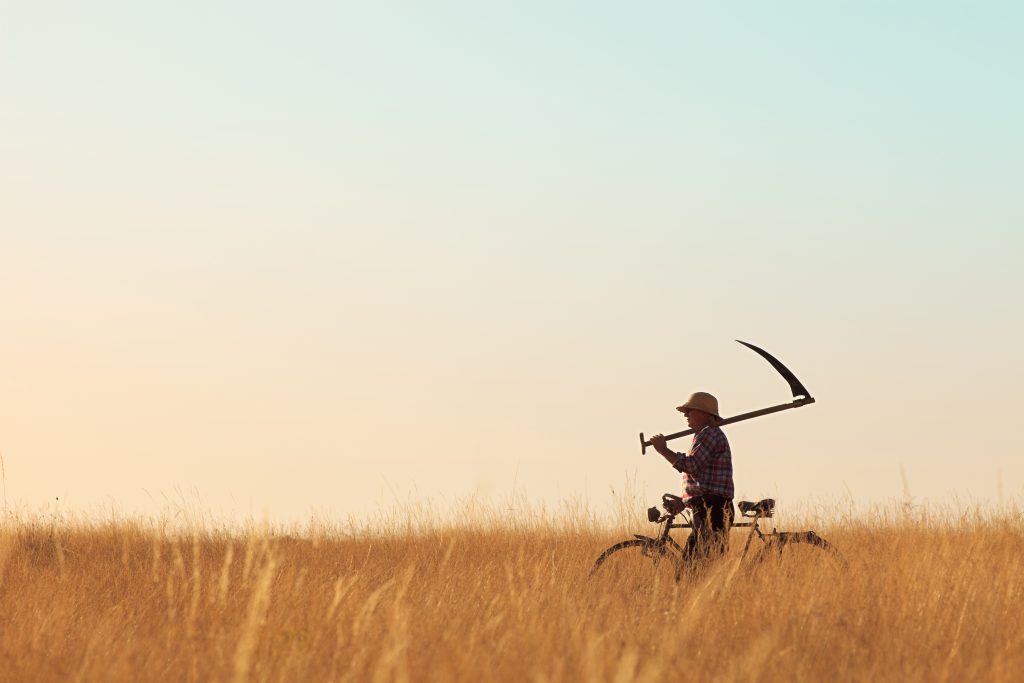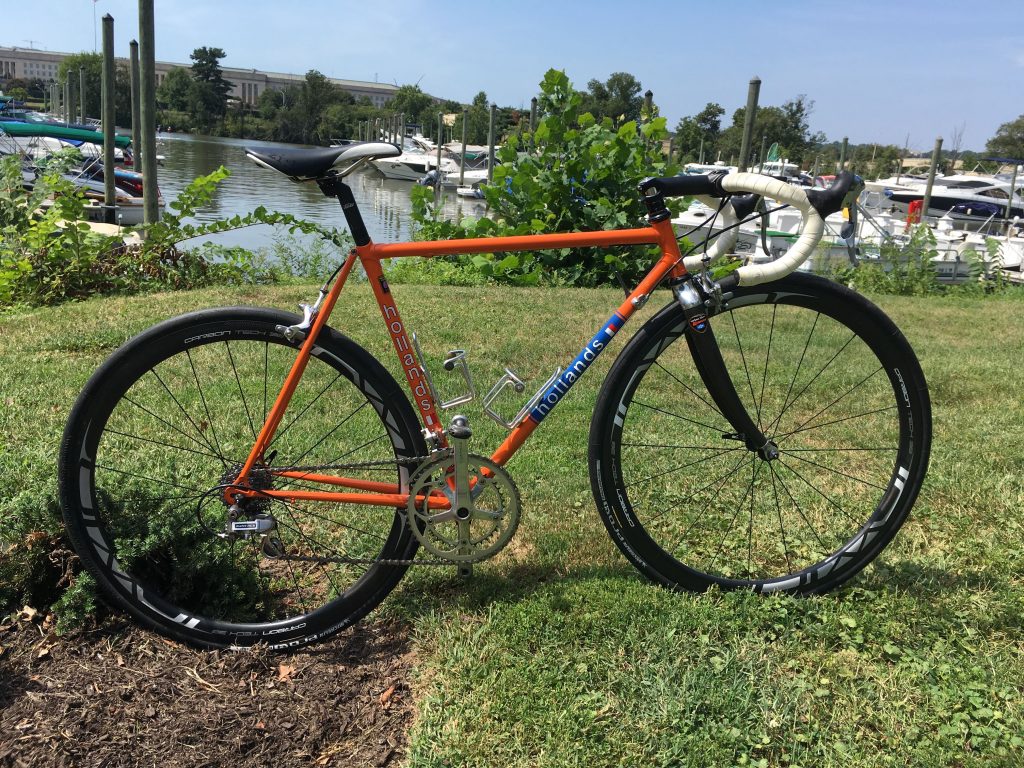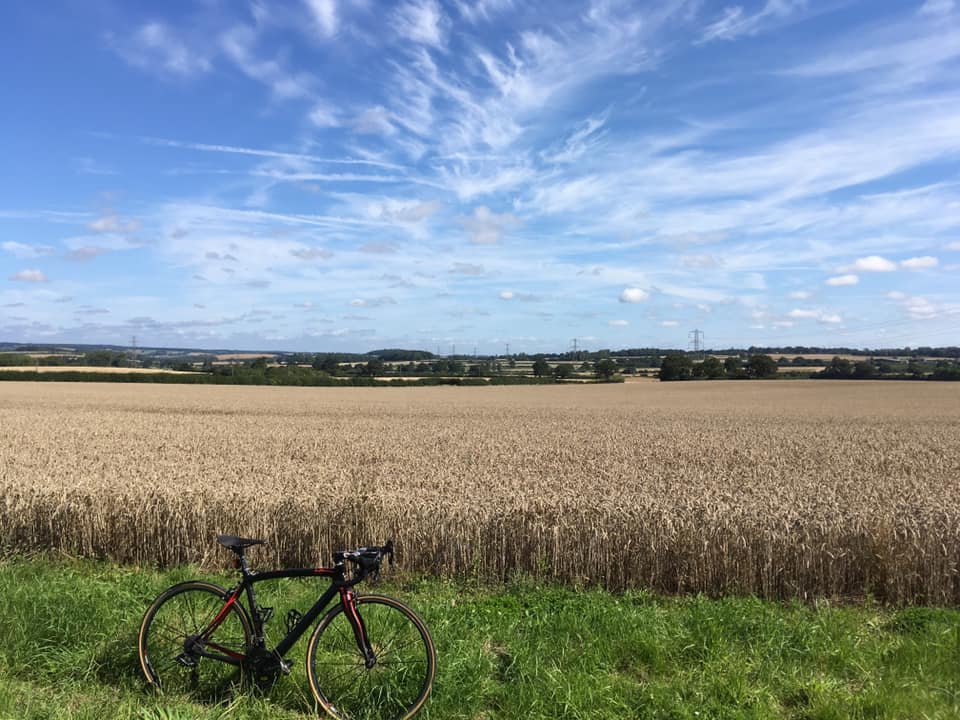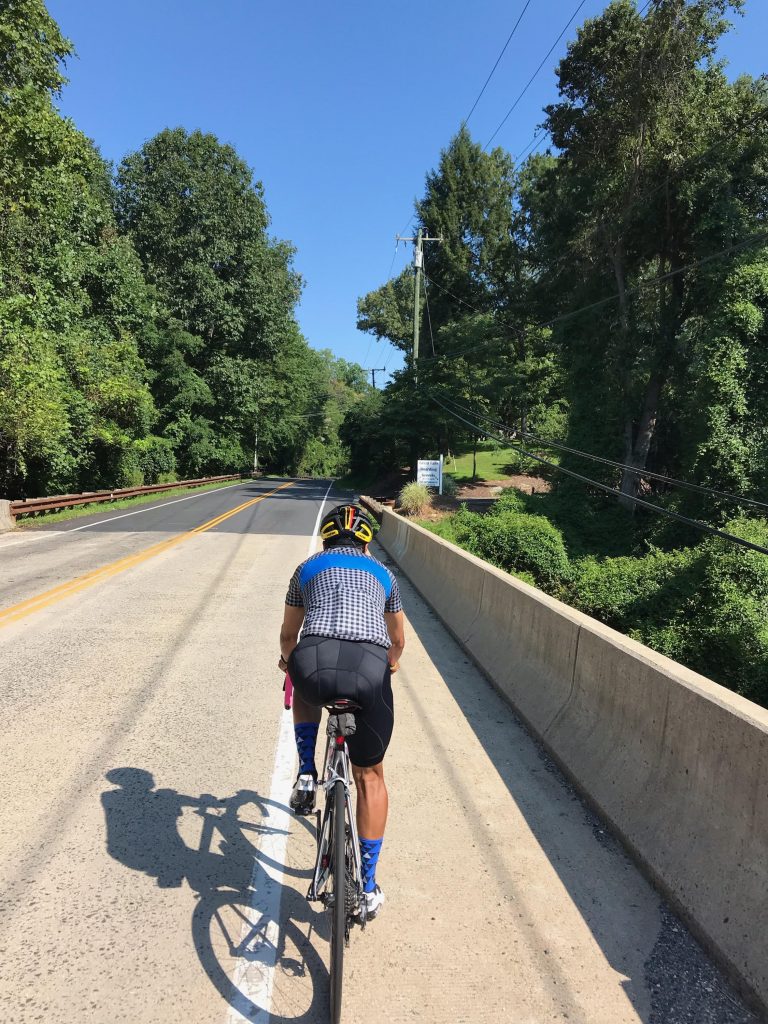Previous Posts
- Home made Energy Bars September 30, 2019Teocalli3503
Bet you never expected a cooking lesson here!
I’ve been making my own energy bars for a few years now. I find these are way easier to eat vs commercial ones as they are less packed and I can vary the mix to taste. Weights volumes below are approximate for starters – adjust to taste.
A4 sheets of Rice Paper
50 g Butter
150 g Treacle / Golden Syrup / Honey
300 g Mixed dried fruit of choice (chop Dates/Prunes/Apricot, Sultanas, Cranberries, Mango etc)
200 g Oats
50 g Whey powder /Powdered Milk
50 g Chopped nuts (I use Almonds and Walnuts – adjust to taste)
Desiccated Coconut (adjust to taste)
1 Tsp Mixed Spice (adjust to taste)
Splash of Lemon Juice (adjust to taste)
Melt the butter, syrup, dried fruit in a pan and simmer.
Mix the mixed spice into the oats and add to wet mix progressively and stir in till all is moist. Add more Oats if it appears too sticky. It should be getting hard to get the oats to absorb moisture but if you have oats that are dry after stirring in for a while then add more syrup.
Pour contents into a tray and press down. Bake circa 150 degrees for 25-30 mins. This works best if your tray is approx. 20 cm wide for the A4 Rice paper.
When cool cut into strips about 2.5 cm square.
Cut A4 rice paper into half size, dampen with a pastry brush and roll the bars in the paper. This is tricky to get the paper just wet enough to roll – too much and the paper just collapses into a sticky modge! Takes a bit of practice and you have to be quick! Best to be too dry to start with then seal with more water once each bar is wrapped.
Leave bars to dry on a drying rack.
Put in a plastic pouch in your pocket otherwise the rice paper will go soggy (sweaty rice paper – yuch!). I’ve collected a few pocket sized plastic bags for 1, 2 or 3 bar rides. Really easy just to reach into your pocket and break off a piece and as they are not as dense as commercial bars they are much easier to chew and swallow. Plus you can make them to your own taste.
Continue reading → - UCI Road World Championships September 22, 2019Teocalli3540
The Worlds this year are in God’s Own County capping off a great series of events over the last few years in Yorkshire.
For the OTRL we have selected only the Men’s and Women’s Road Races to save having a frenetic sequence of picks – and me trying to keep track of things.
So we have the Women’s Road Race on Saturday 28th and the Men’s Road Race on Sunday 29th.
For the Women, how fitting would it be for Lizzie Deignan to bow out with another win. Personally, I will be tooting for her.
For the Men, will the new young guns on the block be able to outwit the more experienced players – will Coppi be proved right “Age and treachery will overcome youth and skill”?
Last year’s top 5 were:
Women
- Anna van der Breggen (Netherlands)
- Amanda Spratt (Australia)
- Tatiana Guderzo (Italy)
- Emilia Fahlin (Sweden)
- Malgorzata Jasinska (Poland)
Men
- Alejandro Valverde (Spain)
- Romain Bardet (France)
- Michael Woods (Canada)
- Tom Dumoulin (Netherlands)
- Gianni Moscon (Italy)
Details on schedule, routes and riders can be found here.
Continue reading → - Rediscovering The Hum September 16, 2019Teocalli3417
Lead photo by Teocalli
There is nothing quite like The Hum of a good set of tyres on a smooth road when you are fit and in tune with the world and setting good pace with a tempo that feels effortless.
So it’s frustrating, or distressing, when you lose the main part of that scenario, fitness and suddenly everything seems like hard work.
With my health issues over the last year moments where I felt The Hum were few and far between.
Where a weekend ride with my main buddy was usually around 120 Km, in the early months of this year I was reduced to survival mode on a ride of 60 Km. I don’t mind admitting that on more than one occasion I was nearly reduced to tears as my main buddy would effortlessly ride away from me.
Happily though, things seem to be in a good place at the moment and most of my fitness has returned and lately I suddenly realised that I had rediscovered The Hum. It felt really good to be at peace with the world and in that zone.
It started me thinking as to what else goes into the sound and feeling of the whole thing. I know it has been claimed that it is mostly down to whether you run Tubs – which I don’t (other than on my Vintage Rigs) also, that it is improved by Latex tubes vs Butyl, some of that I agree with as I run Latex on #1. However, in IMHO it is mostly down to the tyres.
Specifically, and while cotton tyres generally seem to be give a good result and are my construction of choice for all my bikes, I’m sure that the best sound I’ve ever had was from the original (?) Vittoria Corsa and Pave with the Herring Bone tread pattern. The modern Corsa are pretty good and give a great ride but I’m sure that the sound generated by the Grooved cut of the modern tread is not as good as it was with the older Corsa Herringbone tread.
Then again, as sound takes energy to generate it, should we really be wanting to hear The Hum or just be breezing along in total silence?
I am also seriously considering giving Tubeless another go as I think some of the sealants have improved and the latest Scwalbe One Tubeless claim not to be the complete b*&^@rds to get on and off as were the previous version.
Incidentally, the lead photo was a complete accident. We had a team riding Dunkerque Roubaix a few years back and we went out on a shake down the evening before the event. While taking some photos of our team on the roll I accidentally fired the camera in a few odd places but really liked this accidental shot.
Continue reading → - Felice Gimondi: The Aristocrat by Wiscot September 9, 2019Teocalli3451
Photo: Gimondi – Merckx – Baronchelli
There’s just something about Italians: they have style that few other countries can match. How they do it is a bit of a mystery as they have had sixty-one governments since 1945, and are hardly a by-word for order and, shall we say, civic competence. Yet they produce some of the most iconic examples of fashion and style anywhere as well as some of the most beautiful races on the calendar: Milan-San Remo, the Giro d”Italia and the Giro di Lombardia. Go figure.
Italy also produces some remarkable cyclists who are, strangely enough, as stylish as they are successful. To wit: Felice Gimondi, who tragically passed away the other week while swimming. Gimondi was only the second cyclist (after the Frenchman Jacques Anquetil) to win all three grand tours. He was world road race champion (1973), and also won Paris-Roubaix (1966) at a time when few Italians ventured north of the Dolomites to race. His pro career was a long one – 14 years on only two teams: Salvarani (1965-72) and Bianchi (1973-79). Compared to today’s team-hopping riders, that’s amazing consistency and loyalty.
His palmares are incredible, 143 amateur and professional wins, 56 seconds, 38 third place. His first, and only, Tour win was in 1965 at the precocious age of 22 as a neo-pro. His immediate success was a blessing as between 1965 and 1969 he won the Tour, Paris-Roubaix, Giro di Lombardia (1966), the Giro d’Italia (1967 and 69), the Grand Prix des Nations (1967 and 68), and the Vuelta (1968). This remarkable run of success was dampened somewhat by the arrival in 1969 of a young Belgian called Eddy Merckx who soon earned the nickname “the Cannibal” for his insatiable appetite for winning. Merckx “dampened” a lot of careers, but Gimondi remained in the top echelon winning the Tour of Romandie (1969 and 71), Volta a Catalunya ((1972), World Road Championship, Giro del Piemonte, Giro di Lombardia, Trofeo Baracchi, Coppa Bernocchi, Giro di Puglia (1973), Milan San Remo (1974) and a final Giro in 1976.
In summation, he won five grand tours, four Monuments plus some other major wins such as the Trofeo Baracchi which was the unofficial two-up Time trial championship.
Gimondi was a pivotal figure in Italian cycling. The days of Fausto Coppi , Gino Bartali and Fiorenzo Magni were over and the bitter rivalry of Moser and Saronni yet to begin. Gastone Nencini had won the Tour in 1961 but then came Anquetil’s four-in-a-row. Gimondi’s 1965 win was the last Italian victory until Marco Pantani’s in 1998. Riders like Gianni Motta and Marino Basso showed promise but never fully rose to the top. From 1950 with Coppi’s win until 1978 and the first of Francesco Moser’s three wins, the only Italian to win Paris-Roubaix was Gimondi. He arguably kept Italian cycling alive during those years of Merckx’s domination. I’m not overestimating things: such was Merckx’s dominance plus other foreigners winning the Giro in the early 70s, Italian broadcaster RAI stopped covering the race live. No TV? No sponsors. No teams. Things were bad and Gimoindi arguably proved one of the few consistent bright sparks on the scene.
As successful as he was, another defining attribute of the man from Bergamo was his tenacity. Ask any rider whose peak career years coincided with those of Merckx and each one would say that had it not been for the extra-terrestrial Belgian, their palmares would have been much more illustrious. Gimondi fought Merckx tooth-and-nail in so many races and sometimes won: for example the 1973 World Championship where he beat Freddy Maertens, Luis Ocana and Merckx – on the brutal Monjuich circuit in Barcelona.
But back to style. Gimondi was blessed to have worn some of the greatest jerseys ever: the Salvarani pale blue, the World Championship’s rainbow bands, the Maillot Jaune, the Maglia Rosa, the Italian road champion’s tricolore and the classic celeste Bianchi. These were all coupled with black shorts, short white socks and black leather shoes and made for unassailable cycling sartorialism. He even had the audacity to age spectacularly well, keeping a fine head of hair, his figure trim and dressed in that casual style to which Italian men know the secrets. No wonder one of his nicknames was “The Aristocrat” – he had that demeanor to him.
With the passing of Gimondi, cycling has lost another legend. Patrick Sercu, a contemporary of the Italian’s, passed away earlier this year. The great riders of the 60s and 70s are leaving us physically, but leaving behind accomplishments and successes that still thrill. Just watch Stars and Watercarriers, Jorgen Leth’s masterful film of the 1973 Giro. Arguably the best cycling film ever made and Gimondi is right in there, finishing second to an imperious Merckx.
How beloved was Gimondi? Over 2000 people attended his funeral which was broadcast on television. Of all the tributes that poured in about a rider who seems to have been universally beloved, it was the one from his arch rival, nemesis and friend Eddy Merckx that expressed the most sorrow. “What can I say, I am destroyed,” Merckx said. “Felice was first of all a great man, a great champion, and unfortunately, they took him away. It’s a big loss for cycling. All the struggles we have done together come to mind… A man like Gimondi is not born every day, with him goes a slice of my life. He was among the greatest ever.” Merckx did not attend the funeral, so deep was his grief.
There are few left that Merckx will mourn in such a way.
Continue reading → - Steel is real and fish tacos September 3, 2019chuckp3497
Took the Hollands out for a spin over the Labor Day weekend. Lunch date ride with my wife to Island Time Bar & Grill at Columbia Island Marina. Great fish tacos! For those of you not familiar with Babylon on the Potomac, that’s the Pentagon in the background.
Continue reading → - OVO Tour of Britain September 3, 2019Teocalli3486
Lead photo: Kelso in the rain by LiveBorders
Thanks Dan Collins – I nearly Delgado’d the next event the OVO Tour of Britain. Maybe next year I’ll filter out (some) overlapping events to help my poor old addled brain!
Anyway, picks are now open for the OVO Tour of Britain starting Sat 7th Sept.
Top 5 from 2018 were:
- Alaphilippe
- Poels
- Roglic
- Bevin
- Jungels
Usual further details and start list can be found here.
As usual for the UK at this time of the year the weather could deliver anything, particularly “Up North”. So with 3 stages North of the Border and most of the rest in Northern England the scenery will be stunning…..if you can see it!
PS – OK, yes, the photo is a Triathlete………..
Continue reading → - GP de Plouay August 27, 2019Teocalli3460
Lead Photo: CyclingNews
This week we are back with a women event after a short break. The GP Plouay Bretagne has existed as a women event since 2002 and runs on Saturday, the day before the men’s race. The race takes place around the Breton village of Plouay in Western France.
Top 5 from 2018 were:
- Lizzie Deignan
- Pauline Ferrand-Prevot
- Sarah Roy
- Eugenia Bujak
- Elena Cecchini
Will Lizzie manage to sign off her career with a final win?
Struggling to find a succinct riders’ list at the moment so if anyone has a link please post it! A partial list is here.
The organisers event page can be found here with a longhand list of teams and riders.
Full start list here.
Continue reading → - Late Summer Ride August 23, 2019Teocalli3456
Photo from a late Summer ride. Just after the photo a Combine Harvester came through so thought it best to move my bike!
Continue reading → - Give me a break by ChrisO August 12, 2019ChrisO3402
Lance Armstrong had to wait 17 years for his first.
Cadel Evans managed it three times in one season.
Speak to any group of cyclists and it’s almost inevitable one of them will have broken their collarbone. Or as one study put it in the dry language of academia:
“there was a statistically significant association between cycling practice time and frequency of clavicle fractures”.
No shit Sherlock.
According to the research* if you’ve been riding more than 10 years or training more than 10 hours a week the chances are nearly one in four, although surprisingly there was no correlation to number of races.
So I guess at 52 I was doing pretty well to be a late joiner to the Collarbone Club.


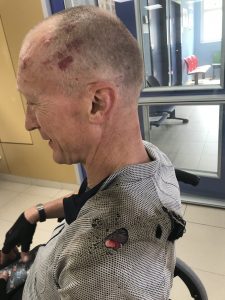
I liked that jersey…
A cycling holiday in the Basque region of Spain was cut short by a crash which I still can’t quite explain. A little mist, a corrugation in the tarmac, a moment’s inattention as I started a descent… who knows.
What I did know almost immediately was that this was a not a crash I was going to be riding away from, tube clenched between my teeth in the style of Fiorenzo Magni. All those classic TV images of pro cyclists looking like a wounded bird surrounded by wheels and broken carbon suddenly made sense. You just know.
Happily my bike was OK and I was with a supported tour group who were able to scoop me up and take me to the nearest hospital (the Basque word is ‘klabikula’ if you ever need it, thank me later).
Patched up to seek further advice on my return to the UK I had plenty of time to put together this handy guide based on research and personal experience for anyone thinking of breaking their own collarbone. (Disclaimer – proper medical advice is here.)
What is it?
They say the collarbone is designed to be broken. It’s like a suspension strut between the breastbone and shoulders and it anchors a lot of ligaments. It absorbs impact up to a point and for cyclists who fall on an outstretched arm the collarbone often tends to break first.


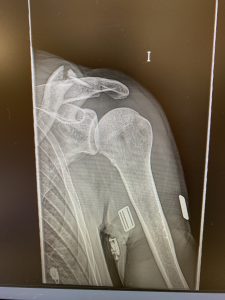
Yep, it’s broken.
You’ll probably be able to feel the break, assuming nothing has broken the skin. And head to the hospital as soon as you can, unless you have to finish a stage of the Tour of course.
How is it treated?
You may be given a sling or an immobiliser, like a figure of eight that goes around your neck and shoulders. I was told that in the UK medical opinion is against these because they don’t help healing. My own experience was that the immobiliser was good in the early days to just take the weight of the arm. And a sling is a good visual cue for others not to engage in any shoulder-punching camaraderie just yet.
Like any bone it can be a simple break or a complicated one with possibly several pieces. I learned a new medical word ‘comminution’ which is a nice way to say splintering. Silver linings and all that.
Your doctor will discuss the options which boil down to surgery or just leaving it to heal but some basic questions will be:
- Is the bone reasonably aligned? It’s broken but how close together are the pieces and can they join up. You might be sent for a CT scan to give different angles from an X-ray.
- Is it going to be the same length? The chances of problems with the rotator cuff in your shoulder are increased by collarbone injuries and more so if the bone heals shorter.
Surgery will be more likely if the answer to those questions is no. In that case a metal plate and pins will be used to hold the bones in place while they repair themselves.


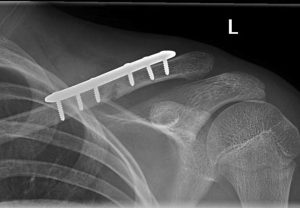
In terms of recovery time there isn’t a huge difference between healing and surgery, although it will probably reduce pain more quickly.
The other advantage of surgery is that you know it’s fixed. If the bones don’t heal naturally then in two or three months you’re going to have had a lot of pain and still need surgery to start again. This certainty is the main reason why pros often go for the surgical route.
On the other hand leaving it to heal means avoiding the general, although small, risks attached to any surgical procedure. It’s also quite common in people with lean builds like cyclists to want to remove the metal at a future date – that means another operation and another period of recovery while the bones are in a weakened state with holes left by screws.
In my own case the complicating factors were the splintering, sorry ‘comminution’, and also a hairline fracture running along the bone. This would have meant a quite large plate to extend past those areas so the body was left to do its work.
Recovery
As I write this I’m only a little more than four weeks past the accident. I was on the trainer indoors in 10 days and did my first track session at four weeks to the day.
Unless the fracture is unstable or painful then it’s just a matter of doing what you can bear, quite literally. The main risk is another injury while the bone is still recovering so try not to crash, as my wife often helpfully suggests. Official NHS advice is not to return to any contact sport for 8 weeks.
What’s actually happening inside takes place in three stages.
- Inflammation – blood rushes to the area and a hematoma or blood clot is formed around the broken bones. This lasts for about a week.
- Repair – cartilage and tissue, known as a callus, is formed around the end of the broken bones and these gradually rejoin over 2-3 weeks. The callus transforms into a spongy bone structure.
- Remodelling – the spongy bone becomes classic hard bone with blood vessels inside as the fractures are rejoined. Sometimes a swelling or lump remains over the end.
Can I do anything?
There are some useful NHS and other guides to beginning basic mobility and stretching and physiotherapy will be helpful in terms of regaining strength.
Obviously the body has to work hard to repair the bones so good diet and rest are important. Some people report being very tired in the early weeks after a fracture and I had a few nights where I crawled into bed while it was still light outside.
With a healthy diet anyone should have enough nutrients. Supplements and natural remedies are a personal choice but general advice is to make sure you have plenty of protein and calcium. Vitamin D helps your body absorb calcium and Vitamin C helps produce collage, while iron and potassium (bananas) are also beneficial for blood and mineral absorption.
Apart from that it’s just a matter of time and recovery. Within 6-8 weeks the bones should be functionally re-formed and pain should have subsided, although the full healing process may continue for several years.
By that stage you may well have broken something else… happy riding.
*Nishimi AY, Belangero PS, Mesquita RS, Andreoli CV, Pochini AC, Ejnisman B. FREQUENCY AND RISK FACTORS OF CLAVICLE FRACTURES IN PROFESSIONAL CYCLISTS. Acta Ortop Bras. 2016;24(5):240–242.
Continue reading → - On the front August 12, 2019chuckp3410
I wish I could say that this is a regular view of my riding partners because I’m the strongest of the bunch. But alas, not. Usually just because I’m the only person who knows where we’re going.
BTW, that’s my new lid: Lazer Z1 Flanders special edition. If y’all are wondering about the jersey: it’s a previous model year Danny Shane.
Continue reading →
